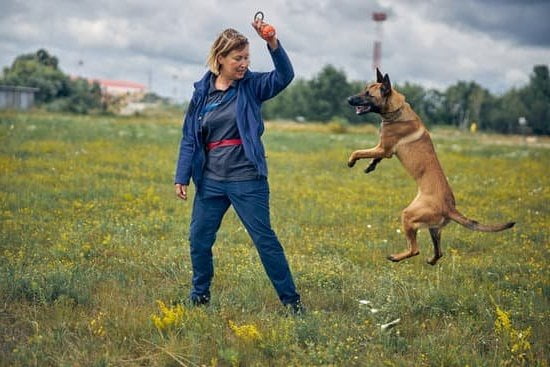Training your dog to heel is an essential part of obedience training and is a foundational skill for a well-behaved pet. The heel command teaches your dog to walk calmly and closely by your side, without pulling or straying. In this article, we will explore the key components of heel training, from understanding the importance of the command to choosing the right equipment and mastering advanced techniques.
Heel training is not only beneficial for establishing control and discipline with your dog, but it also fosters a stronger bond between you and your furry companion. By teaching your dog to heel, you are providing them with clear expectations and boundaries while out for walks or in public settings. Furthermore, proper heel training can enhance safety for both you and your dog by preventing them from darting off or getting into potentially dangerous situations.
In the following sections, we will delve into the various aspects of heel training for dogs, including basic commands and techniques, common mistakes to avoid, as well as troubleshooting challenges that may arise. Whether you are a first-time pet owner or looking to improve your existing skills, this comprehensive guide will equip you with the knowledge and tools needed to successfully train your dog to heel effectively.
So let’s dive in and master the art of heel training for a well-behaved canine companion.
The Importance of Heel Training for Dogs
Properly trained dogs are also much more pleasant to be around in social settings. Whether at a park, a vet’s office, or in the presence of other animals, a well-trained dog will stay calm and composed when commanded to heel. Additionally, if a dog is ever off-leash, a strong foundation in heel training means it will be more responsive to verbal commands and less likely to wander away.
To effectively train your dog to heel, it’s important to use appropriate equipment such as a sturdy leash and collar or harness. Positive reinforcement techniques and consistent training sessions are also essential for success. By using treats, praise, and patience, you can gradually teach your dog to understand and respond to the heel command in various environments and situations. Understanding your dog’s breed traits and temperament is also important when devising a training plan.
| Importance of Heel Training | Benefits |
|---|---|
| Enhanced safety during walks | Improved obedience |
| Better behavior in social settings | Decreased likelihood of dangerous situations |
Choosing the Right Equipment for Heel Training
When it comes to training your dog to heel, choosing the right equipment is essential for a successful training experience. The right equipment will not only help you effectively communicate with your dog but also keep both of you safe during training sessions. Here are some key factors to consider when selecting the right equipment for heel training.
Collars and Leashes
The most common equipment used for heel training is a collar and leash. When choosing a collar, opt for one that fits comfortably around your dog’s neck without being too tight or too loose. A standard flat collar or martingale collar can be effective for heel training. As for leashes, a 4 to 6-foot leash made of leather or nylon is ideal for controlling your dog’s movements during training sessions.
Harnesses
Some owners prefer using harnesses for heel training, especially if their dogs have a tendency to pull on the leash. Front-clip harnesses are particularly helpful in redirecting your dog’s attention back to you when they try to pull ahead. However, it’s important to ensure that the harness fits properly and doesn’t cause discomfort or restrict your dog’s movements.
Treats and Reward Pouches
In addition to collars and leashes, using treats as rewards is an effective way to motivate and reinforce desired behavior during heel training. Consider investing in a reward pouch that attaches to your waist or belt, so you can easily access treats during training sessions without fumbling with pockets or treat bags. This setup allows you to seamlessly deliver treats at the precise moment when your dog exhibits the correct heeling behavior.
By carefully selecting the right equipment for heel training, you set yourself and your furry companion up for success from the start. Keep in mind that each dog is unique, so it may take some trial and error before finding the perfect combination of equipment that works best for both of you while learning how to train dogs to heel effectively.
Basic Commands and Training Techniques for Heel Training
Training your dog to heel is an essential skill that can make walks and outings with your furry friend more enjoyable for both of you. The heel command teaches your dog to walk closely by your side, without pulling on the leash or wandering off. Here are some basic commands and training techniques to help you teach your dog to heel.
First, start with the basic sit and stay commands. These commands are foundational for teaching your dog to heel, as they establish your position as the leader and set the stage for successful heel training. Practice these commands until your dog responds consistently before moving on to heel training.
Next, choose a leash and collar that is best suited for heel training. A well-fitted collar or harness, along with a sturdy leash, will give you better control over your dog during training sessions. Avoid using retractable leashes, as they can make it difficult to maintain a consistent heel position.
Once you have the right equipment in place, begin practicing the heel command in a low-distraction environment. Start by walking with your dog on a loose leash and give the verbal cue “heel” as you begin walking. Use treats or toys to encourage your dog to stay by your side, rewarding them when they maintain the proper position. With consistent practice and positive reinforcement, your dog will learn how to walk nicely on a leash without tugging or straying.
Common Mistakes to Avoid When Training Dogs to Heel
Training your dog to heel can be a challenging but rewarding experience. However, there are some common mistakes that many dog owners make when attempting to train their dogs to heel. By being aware of these mistakes and taking steps to avoid them, you can set yourself and your furry friend up for success in mastering the heel command.
Not Using Positive Reinforcement
One of the biggest mistakes that owners make when training their dogs to heel is using punishment-based methods. It’s important to remember that positive reinforcement is the most effective way to train your dog. Instead of scolding or physically correcting your dog when they fail to heel, use treats, praise, and rewards to encourage the behavior you want. This will create a positive association with heeling and make your dog more eager to comply.
Inconsistency
Another common mistake is being inconsistent with your training. This can include giving mixed signals by allowing your dog to pull on the leash sometimes, or not enforcing the heel command in certain situations. Consistency is key when it comes to training dogs in any behavior, including heeling. Make sure that everyone who interacts with your dog also follows the same rules and expectations for heeling, so as not to confuse the animal.
Expecting Too Much Too Soon
It’s important for dog owners to remember that training a dog takes time and patience. Many owners make the mistake of expecting their dogs to master the heel command quickly, and become frustrated when progress is slow. Remember that every dog learns at their own pace, and it’s important not to rush the process.
Set realistic goals for your training sessions and be patient with your furry companion as they learn how to properly heel. With consistent practice and positive reinforcement, you will eventually see improvements in their behavior on walks.
Advanced Heel Training Techniques for Obedience and Distraction
When it comes to advanced heel training techniques for obedience and distraction, it’s important to build on the foundation of basic commands and training techniques. Here are some advanced techniques to further reinforce the heel command and ensure your dog can maintain focus and obedience in various situations:
1. Increase Distractions: Once your dog has mastered the heel command in a controlled environment, gradually introduce distractions such as other dogs, people, or even enticing scents. This will test your dog’s ability to maintain focus and obedience while walking in crowded or stimulating environments.
2. Use Variable Rewards: Instead of rewarding your dog with a treat every time they heel successfully, use variable rewards to reinforce the behavior. This means sometimes offering a treat, other times providing verbal praise or a favorite toy. This will prevent your dog from becoming too reliant on food rewards and encourage them to heel consistently regardless of the reward.
3. Practice Off-Leash Heeling: Once your dog is reliably heeling on-leash, you can start practicing off-leash heeling in a safe, enclosed area. This advanced technique requires a strong foundation in basic heel training and a deep level of trust between you and your dog. Start small and gradually increase the duration of off-leash heeling as your dog demonstrates their ability to stay focused and obedient without the restriction of a leash.
By implementing these advanced heel training techniques for obedience and distraction, you can help your dog become a well-behaved companion both on – and off-leash. Remember that consistency, patience, and positive reinforcement are key elements in successfully teaching your dog how to heel in any situation.
Troubleshooting
When it comes to training dogs to heel, there are often challenges that dog owners may face. Addressing these challenges is essential in ensuring that your dog becomes well-behaved and obedient while walking on a leash. Here are some common challenges in heel training and how to address them:
- Pulling on the Leash: One of the most common challenges when teaching a dog to heel is constant pulling on the leash. This can make walks frustrating for both the owner and the dog.
- Distractions: Dogs can easily get distracted during walks, whether it’s by other animals, people, or even just interesting scents. This can cause them to stray from the heel position and ignore commands.
- Lack of Focus: Some dogs may have difficulty maintaining focus during heel training, making it challenging for them to understand and follow the commands consistently.
To address these challenges, consistency and patience are key. Using positive reinforcement techniques such as rewarding your dog with treats or praise when they successfully heel can help encourage good behavior.
Another important aspect of troubleshooting in heel training is to gradually increase distractions and duration during training sessions. Start off in a controlled environment with minimal distractions, then slowly introduce more challenging situations as your dog progresses.
It’s also important to ensure that your dog is comfortable with the equipment being used for heel training. If your dog seems uncomfortable or resistant to wearing a collar or leash, consider trying different types of equipment to find what works best for them.
By addressing these common challenges and using effective training techniques, you can successfully train your dog to heel and enjoy peaceful walks together. Remember that consistent practice and positive reinforcement are essential for achieving success in heel training.
The Benefits of Consistent Heel Training for Dogs and Owners
Consistent heel training for dogs comes with a variety of benefits for both the dogs and their owners. Not only does it improve the overall behavior and obedience of the dog, but it also strengthens the bond between the pet and its owner. Properly trained dogs are easier to manage, which can lead to a more peaceful and harmonious relationship with their owners.
One of the key benefits of consistent heel training is that it ensures the safety of both the dog and its owner. When a dog is trained to heel, it will stay close to its owner and not run off into dangerous situations, such as traffic or unfamiliar territory. This can prevent accidents and keep the dog out of harm’s way.
In addition, consistent heel training can also provide mental stimulation for the dog. Training sessions require focus and concentration, which can help to tire out energetic dogs and prevent behavioral issues caused by boredom. Mental stimulation through training can also strengthen the bond between dogs and their owners, as it provides an opportunity for positive reinforcement and communication.
Conclusion
In conclusion, mastering the heel command is an essential aspect of training for a well-behaved dog. Through understanding the importance of heel training and choosing the right equipment, owners can effectively teach their dogs to walk politely on leash. By establishing and consistently reinforcing basic commands and training techniques, such as proper body positioning and positive reinforcement, dog owners can ensure their pets learn how to heel in various environments.
It’s important to be aware of common mistakes to avoid when training dogs to heel, including using punishment-based methods or allowing the dog to pull on the leash. Instead, advanced heel training techniques involving obedience and distraction should be implemented to further solidify a dog’s ability to stay by their owner’s side while walking.
In addressing any challenges that arise during heel training, such as stubbornness or distractions, owners can troubleshoot by providing consistent practice in different settings and using motivating rewards.
The benefits of consistent heel training extend beyond simply walking with a well-mannered dog. This level of obedience fosters a deeper bond between owner and pet, enhances safety during walks, and promotes better behavior overall. By following the guidelines laid out in this article on how to train dogs to heel, both dogs and their owners can experience improved communication and mutual respect while enjoying daily activities together.
Frequently Asked Questions
How Long Does It Take for a Dog to Learn Heels?
The time it takes for a dog to learn to heel can vary depending on the individual dog and their previous training experience. Some dogs may pick up the command quickly, while others may take longer to master it.
What Age Can You Teach a Dog to Heel?
You can start teaching a dog to heel at any age, but it’s often best to begin training when they are still young and more receptive to learning new commands. Puppies as young as 8-10 weeks old can start learning the basics of heeling.
How Do I Teach My Dog to Heel Positive Reinforcement?
Positive reinforcement is key when teaching a dog to heel. Use treats, praise, and rewards to encourage your dog to walk beside you in the proper position. Consistency and patience are essential when using this method of training.

Welcome to the blog! I am a professional dog trainer and have been working with dogs for many years. In this blog, I will be discussing various topics related to dog training, including tips, tricks, and advice. I hope you find this information helpful and informative. Thanks for reading!





